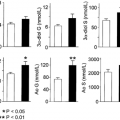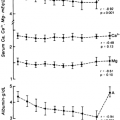EVALUATION OF THE FETAL-PLACENTAL UNIT BY ENDOCRINE TESTING
Because of the enormous increases in hormone levels in pregnant women, it was originally hoped that fetal stress in utero could be detected by documenting changes in hormones secreted by the fetal-placental unit. The initial goal was to be
able to measure a single or group of hormone changes that would guide the physician in the management of high-risk pregnancies: If an abnormal level of a hormone or hormones were detected, the physician would interrupt the pregnancy to prevent death or significant morbidity to the fetus.
able to measure a single or group of hormone changes that would guide the physician in the management of high-risk pregnancies: If an abnormal level of a hormone or hormones were detected, the physician would interrupt the pregnancy to prevent death or significant morbidity to the fetus.
EARLY PREGNANCY
To evaluate the newly implanted and growing embryo, quantitative serum β-hCG or serum progesterone has been used. These tests have been used most often to evaluate women with uterine bleeding in early pregnancy, ectopic pregnancy, luteal phase dysfunction, or a history of habitual abortion. Although serum levels of progesterone may decline before a spontaneous abortion, the clinical usefulness of this test is uncertain.138 Because most spontaneous abortions are not the result of progesterone deficiency, declining progesterone levels often signify dying trophoblasts and a nonviable pregnancy.
With the development of accurate and rapid quantitative measurements of β-hCG in serum, these tests have been used extensively to confirm a normal developing embryo and trophoblast in women treated for various forms of infertility (see Chap. 112). A doubling of the β-hCG levels at ˜48-hour intervals usually signifies a normal viable intrauterine pregnancy,139 whereas low or falling levels are usually associated with an inevitable abortion or an ectopic pregnancy.140 The number of days required for β-hCG levels to normalize following pregnancy and pregnancy complications is seen in Table 108-1.
Stay updated, free articles. Join our Telegram channel

Full access? Get Clinical Tree





